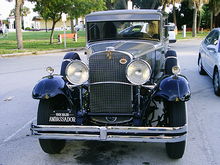Rambler is an automobile brand name that was first used by the Thomas B. Jeffery Company between 1900 and 1914.

A hatchback is a car body configuration with a rear door that swings upward to provide access to the main interior of the car as a cargo area rather than just to a separated trunk. Hatchbacks may feature fold-down second-row seating, where the interior can be reconfigured to prioritize passenger or cargo volume.

The Chevrolet Corvair is a compact car manufactured by Chevrolet for model years 1960–1969 in two generations. A response to the Volkswagen Beetle, it remains the only American-designed, mass-produced passenger car with a rear-mounted, air-cooled engine. The Corvair was manufactured and marketed in 4-door sedan, 2-door coupe, convertible, 4-door station wagon, passenger van, commercial van, and pickup truck body styles in its first generation (1960–1964) and as a 2-door coupe, convertible or 4-door hardtop in its second (1965–1969) – with a total production of approximately 1.8 million from 1960 until 1969.
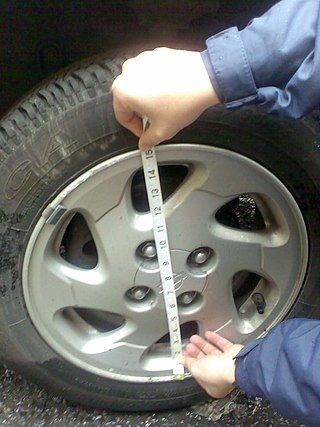
The wheel size for a motor vehicle or similar wheel has a number of parameters.
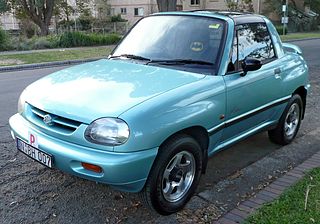
The Suzuki X-90 is a front engine, rear or four wheel drive, two door, two seater car manufactured and marketed by Suzuki for the model years of 1995 to 1997. Related to the Suzuki Vitara, the X-90 featured a T Section removable roof. Replacing the Samurai in the market in the United States, Suzuki began marketing the X-90 in Japan by the end of 1995, and in western markets in April 1996.

The AMC Hornet is a compact automobile manufactured and marketed by American Motors Corporation (AMC) and made from 1970 through 1977—in two- and four-door sedan, station wagon, and hatchback coupe configurations. The Hornet replaced the compact Rambler American line, marking the end of the Rambler marque in the American and Canadian markets.

A police car is a ground vehicle used by police and law enforcement for transportation during patrols and responses to calls for service. A type of emergency vehicle, police cars are used by police officers to patrol a beat, quickly reach incident scenes, and transport and temporarily detain suspects, all while establishing a police presence and providing visible crime deterrence.

The trunk or boot of a car is the vehicle's main storage or cargo compartment, often a hatch at the rear of the vehicle. It can also be called a tailgate.
A glossary of terms relating to automotive design.

Fender skirts, known in Australia and the United Kingdom as spats, are pieces of bodywork attached to or part of the fender that cover the upper portions of the wheels of a vehicle. They are usually used only on rear wheels, but some models have them on all wheels.
A run-flat tire is a pneumatic vehicle tire designed to resist the effects of deflation when punctured, allowing the vehicle to continue to be driven at reduced speeds for limited distances. First developed by tire manufacturer Michelin in the 1930s, run-flat tires were introduced to the public market in the 1980s. They have increased in popularity over time.
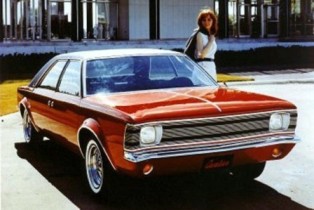
The AMC Cavalier was a compact concept presented by American Motors (AMC) in 1965, noted for symmetrical elements of its design and its interchangeable body parts.
A spare wheel cover or spare tire cover is an accessory that covers the spare wheel mounted on external part of a car or van. On 4x4 vehicles, the spare wheel is normally rear mounted and is often printed with a design. Covers can be hard shells or soft vinyl covers. Spare wheel covers protect spare tires from dirt and UV rays in areas with high sun exposure. Covers are recommended to be removed and cleaned every once in a while.

A flat tire is a deflated pneumatic tire, which can cause the rim of the wheel to ride on the tire tread or the ground potentially resulting in loss of control of the vehicle or irreparable damage to the tire. The most common cause of a flat tire is puncturing of the tire by a sharp object, such as a nail or pin, letting the air escape. Depending on the size of the puncture, the tire may deflate slowly or rapidly.

Airless tires, non-pneumatic tires (NPT), or flat-free tires are tires that are not supported by air pressure. They can be used on small vehicles such as ride-on lawn mowers and motorized golf carts. They also are used on heavy equipment required to operate on sites where risk of tire punctures is high. Tires composed of closed-cell polyurethane foam are also made for bicycles and wheelchairs.

A continental tire or a continental kit is a term used in the United States for an upright externally-mounted spare tire located behind an automobile's trunk, made popular by the Continental Mark Series, which carried a simulated continental tire until 1998.

Inspection and maintenance of tires is about inspecting for wear and damage on tires so that adjustments or measures can be made to take better care of the tires so that they last longer, or to detect or predict if repairs or replacement of the tires becomes necessary. Tire maintenance for motor vehicles is based on several factors. The chief reason for tire replacement is friction from moving contact with road surfaces, causing the tread on the outer perimeter of tires to eventually wear away. When the tread depth becomes too shallow, like for example below 3.2 mm, the tire is worn out and should be replaced. The same rims can usually be used throughout the lifetime of the car. Other problems encountered in tire maintenance include:
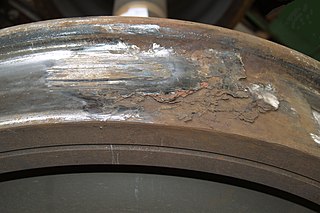
A flat spot, or wheel flat, also called spalling or shelling, is a fault in railroad wheel shape. A flat spot occurs when a rail vehicle's wheelset stops rotating while the train is still in motion, causing part of the wheel to ablate against the hard steel of the rails. Flat spots are usually caused by use of the emergency brake, or slippery (low-adhesion) conditions that cause wheels to lock up while the train is still moving. Flat spots are more common in the autumn and winter when the rails are slippery.
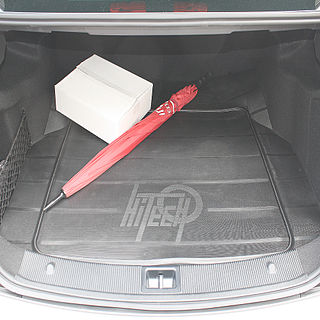
A car boot liner or cargo liner is a synthetic mat designed to protect the automobile boot or trunk against damage from dirt or spills and to pad cargo against abrasion or shock. Specifically, a boot liner shields the vehicle carpet from damage. Boot liners are usually removable, so they may be cleaned or replaced.

The Land Rover Discovery Sport is a compact luxury crossover SUV produced by British automotive company Jaguar Land Rover since 2014, under their Land Rover marque, and since 2017 their best-selling model.


